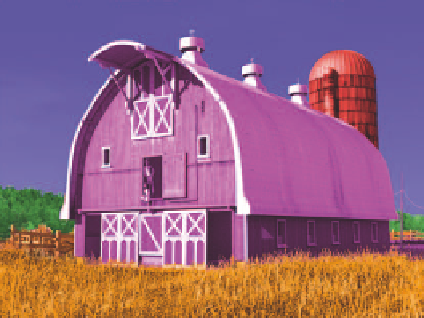Graphics Reference
In-Depth Information
Another thing to consider, especially for outdoor scenes, are distance breaks. Most likely, you will not be ren-
dering an entire foreground-to-horizon environment in live 3D for every frame of your animation. Unless
the camera is spinning wildly, it would be completely unnecessary. If you will be using a statically rendered
distant background, you will need some way to blend that into the foreground. The easiest way to do so is
with distance breaks. Consider the image in Figures 13.27 and 13.28. They demonstrate how the entire shot
can be seen as a series of overlapping layers. The point is that between two of those layers, you will need to
change from live geometry to a prerendered (or painted) still image. Having some sort of physical break line,
like a cresting hillside, will give you an excellent place to make the transition.
Figure 13.27
A rendered outdoor scene
Figure 13.28
The different production layers
You aren't required to have a physical breakpoint, and you won't always be able to have to one, but a line of
trees, a building, or a hillside can make your job during the compositing stage much easier. The actual cre-
ation and integration of background images for your shots will be covered in Chapter 15, Rendering and
Compositing.
Getting Help
This is a good time to discuss getting help with your project. We've encouraged you previously to solicit
feedback on your story ideas, storyboards, and story reel, but that sort of help can come from anyone with eyes
and, at the least, a half a brain. If you have committed to developing the story and characters either by yourself
or with a small group, the fi nalization of sets and props is an excellent opportunity to open the project up to a
larger pool of help. You don't have to, but at this point in the production, going from character animation to
modeling topics on a shelf can feel like a bit of a letdown. It can also take a while. Fortunately, the modular
structure of your sets and object fi les (linked assets) makes it easy for you to farm out these sorts of duties.
The mechanics of doing so are simple. For modeling help, you request one BLEND fi le per object. As you
receive BLEND fi les, you place them in your models directory, or perhaps a subdirectory called
contributed
,


Search WWH ::

Custom Search